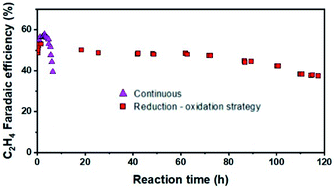In situ regeneration of copper catalysts for long-term electrochemical CO2 reduction to multiple carbon products†
Abstract
The valorization of carbon dioxide (CO2) via electrochemical CO2 reduction (ECR) has attracted great interest as a pragmatic approach to tackle greenhouse gas emissions. Multiple carbon (C2+) products, such as ethylene (C2H4), ethanol (C2H5OH), and propanol (C3H7OH), are highly valuable chemicals and of great demand. Copper (Cu)-based catalysts are so far the only electrocatalytic materials that allow CO2 reduction to C2+ products at industrially relevant current densities (≥100 mA cm−2). However, most Cu-based catalysts are unstable in long-term reactions (>100 hours), with the main reasons being the potential-induced surface reconstruction, deposition of impurities, and catalyst aggregation and leaching, among others. Herein, we report an in situ catalyst regeneration strategy that can extend the operation time of Cu-based catalysts. By periodically adding segments of anodic currents to electrolysis, a Cu catalyst is partially oxidized to CuOx in each cycle, as confirmed by in situ Raman studies, leading to the restoration of the catalytically active sites for C2+ products. We found that the oxidation current density and time significantly affect the selectivity and stability of Cu catalysts. Applying this strategy to a Cu catalyst – which is stable for ∼5 h towards C2+ products during a continuous electroreduction under neutral-pH conditions, we were able to extend the operating time to ∼120 h in a flow cell system. The catalyst maintained a high faradaic efficiency (FE) for C2H4 of ≥50% at a fixed cathodic current density of 150 mA cm−2 for over 60 h and continued to operate with a C2H4 FE ≥ 40% for the entire length of the reaction time. This work opens up an avenue to enhance the stability of Cu electrocatalysts, via controlling the operating procedure during electrolysis.

- This article is part of the themed collection: Journal of Materials Chemistry A Emerging Investigators


 Please wait while we load your content...
Please wait while we load your content...